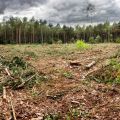Journeying back in time can help us understand our planet’s future: new Museum of Climate Hope trail
21 July 2023
'If you’re looking for something different to do with children this summer, this gives them the opportunity to think...
about environmental change, but also to see that the world does care and they can be instrumental in making a difference'
• New digital trail focusing on anxiety about climate change
• Artefacts in Oxford collection considered through lens of environmental change
• Young people involved in design: learners creatively envisioning the future
• Trail can be completed in person and online
A new digital trail through Oxford University’s gardens, libraries and museums aims to highlight positive steps - addressing climate change anxiety by reframing the stories of real artefacts.
Six of Oxford’s museums have come together, along with Rumble Museum at Cheney School in Oxford, to create the interactive, fun and educational activity which can be completed in person, online, or a mixture of both. Visitors will learn more about the artefacts but also life at that time, through multimedia storytelling from Oxford researchers, museum staff and young people.
What is known about the historical items is combined with what was happening in the world at that time and the experience shows that hope, resilience, transformation and innovation have been around a long time and are key to protecting our world.
Bill Finnegan, from the Environmental Change Institute, the project’s creator, says, ‘Following research I carried out last year on climate education, I became increasingly interested in the concept of hope, and how educators can help young people navigate the space between disengagement and despair.
‘Each artefact featured in this trail tells its own story based on what we know about the item, but with a twist – through the lens of environmental change. This long-term view on the relationships between people and the natural world provides an important perspective on current environmental challenges, as well as models for how to navigate them.’
He maintained, ‘If you’re looking for something different to do with children this summer, this gives them the opportunity to think and talk about environmental change, but also to see that the world does care and they can be instrumental in making a difference, and there is positivity ahead.’
Dr Tina Fawcett, Senior Researcher and Associate Professor at the ECI, explains, ‘This trail provides an opportunity to identify what emotions people have around environmental change and how we can manage them.’
Meanwhile, Dr Courtney Nimura, Curator for Later European Prehistory at the Ashmolean Museum, says, ‘The Museum of Climate Hope Trail celebrates the amazing collections we hold in the Gardens, Libraries, and Museums and highlights their relevance to pressing, everyday issues such as climate change.
‘We hope young people especially, will find inspiration in these stories as they navigate the current climate emergency.’
The trail is particularly aimed at key stages 2 and 3 (ages 7-14) and for teachers bringing primary and secondary school groups to the Oxford museums. Multimedia content will then also be shared digitally for schools to use in their classrooms after their visit.
Young people were involved as much as possible in designing the project. Children and sixth formers from Cheney School helped choose which exhibits to display and researched the stories behind them. Others helped film the artefacts for the videos, making the trail digitally interactive. Items were identified and stories created thanks to the student organising committee of the Oxford Schools Sustainability Network and Members of the Natural History Museum’s Youth Forum.
A survey (Hickman et al, 2021) of ten thousand young people aged 16-25 across 10 countries found 59% were very or extremely worried and 84% were at least moderately worried. More than 50% reported each of the following emotions: sad, anxious, angry, powerless, helpless, and guilty.
More than 45% of respondents said their feelings about climate change negatively affected their daily life and functioning, and many reported a high number of negative thoughts about climate change. For example, 75% said they think the future is frightening and 83% said they think people have failed to take care of the planet.
All partners involved in the trail have worked together to co-create the activity and will evaluate the learning experience to aid future research into environmental issues.
Entry to all the museums and Weston Library is free. Entry to Oxford Botanic Garden is free for children under 16, but there is an admission charge for adults. Please check the Oxford Botanic Garden website for more information.
About the Museum of Climate Hope Trail https://climatehope.uk/
About the Trail:
This museum trail and digital learning experience is aimed at families and school groups. When visiting the museums, gardens and libraries in Oxford, look for labels with the Museum of Climate Hope and a QR code. Use your smartphone camera to scan the QR code, click-through, and view supplemental digital content such as images, text, videos. You can also access this content from your classroom or home by following the link https://climatehope.uk/. The digital content includes resources for educators and opportunities for young people to share the objects and stories that give them hope when it comes to climate change.
Notes to Editors
Media enquiries: Vicki Sperrey, ECI Communications Officer [email protected] or 44 (0)7772 710699
About the Environmental Change Institute
The Environmental Change Institute at the University of Oxford was established in 1991. Its aim is to organize and promote interdisciplinary research on the nature, causes and impact of environmental change and to contribute to the development of management strategies for coping with future environmental change.
About the School of Geography and the Environment
The School of Geography and the Environment (SoGE) is a dynamic, diverse, interdisciplinary academic department at the University of Oxford combining natural and social science interests and skills, underpinned by Geography’s tradition of working across differing cultures. The School is internationally recognized for the quality of its teaching, research and wider engagement across the breadth of human and physical geography and environmental studies.
https://www.geog.ox.ac.uk/
About Rumble Museum
Rumble Museum at Cheney is a unique partnership between an educational charity and a school. The Iris Project, a charity which promotes learning about the ancient world, is working with Cheney School to grow a museum within a school. We have been awarded full Museum Accreditation by the Arts Council Museum Accreditation Scheme.
Cheney School is a secondary school and sixth form with academy status, located in Headington, Oxford, England
About GLAM
Oxford University’s Gardens, Libraries and Museums (GLAM) house some of the world's most significant collections. They provide important places of scholarly enquiry and serve as the front door to the wealth of knowledge and research generated at Oxford, welcoming over 3 million visitors each year.
Oxford University's Gardens, Libraries and Museums form one of the greatest concentrations of university collections in the world. Comprising over 21 million objects, specimens and printed items, they constitute one of the largest and most important research repositories in the world and provide an outstanding resource for scholars, students and members of the public.
About the University of Oxford
Oxford University has been placed number one in the Times Higher Education World University Rankings for the seventh year running, and number two in the QS World Rankings 2022. At the heart of this success are the twin-pillars of our ground-breaking research and innovation and our distinctive educational offer.
Oxford is world-famous for research and teaching excellence and home to some of the most talented people from across the globe. Our work helps the lives of millions, solving real-world problems through a huge network of partnerships and collaborations. The breadth and interdisciplinary nature of our research alongside our personalised approach to teaching sparks imaginative and inventive insights and solutions.
 Nature degradation could cause a 12% loss to UK GDP
Nature degradation could cause a 12% loss to UK GDP
 Landmark study definitively shows that conservation actions are effective at halting and reversing biodiversity loss
Landmark study definitively shows that conservation actions are effective at halting and reversing biodiversity loss
 Researchers find oldest undisputed evidence of Earth’s magnetic field
Researchers find oldest undisputed evidence of Earth’s magnetic field
 Honorary degree recipients for 2024 announced
Honorary degree recipients for 2024 announced
 Vice-Chancellor's innovative cross-curricular programme celebrated
Vice-Chancellor's innovative cross-curricular programme celebrated